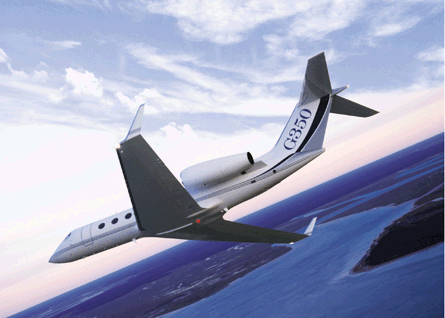For sale on the web is a previously owned Gulfstream 350 that the brokers promise will "earn the CFO's respect as well as the CEO's" as it provides the amenities of a G450, but at $10 million less in purchase price and only "slightly" shorter range.
This particular 2005 G350, however, turned out to be the bane of its owner's top brass, and not because of cost. N5114 is one of seven Gulfstreams in the flight department of US automobile manufacturer General Motors and is a casualty of the battle the company has waged to gain a bridge loan from the US government to avoid bankruptcy and mass layoffs.
GM was not in isolation. Corporate flight departments worldwide came under the microscope late last year as heads of the "Big 3" US automakers - GM, Ford and Chrysler - asked the US Congress for bailout funding in public hearings and were vilified by some lawmakers for arriving in Washington in private jets, despite having perfectly valid reasons for doing so.
 |
|---|
© Gulfstream |
Bowing to public pressure, however, GM as part of a restructuring plan says it will "immediately" cease all corporate aircraft operations and explore "options for transferring the aircraft to another charter service operator and/or pursue disposal of the aircraft." Ford and Chrysler also closed their flight departments, increasing the black eye of an industry already hammered by a plunging economy.
More to the point, the story of N5114 would appear to be proof that the legacy rules for choosing a transport mode no longer apply when it comes to publicly traded companies like the Big 3, says XOJet vice-president of product strategy, Peter Fuchs. The G350 had accumulated 1,675h in 50 months on the job, averaging just over 400h a year, well above the accepted threshold of 300h for when it makes sense to own an aircraft as opposed to chartering or having a fractional share.
In the wake of the Capitol Hill debacle, Fuchs says he has seen a "significant focus of interest" from corporate flight departments on the company's flight programme analyser. "People are looking to their flight departments and are being proactive," says Fuchs. "They want to know what to tell the chief executives when they call."
The analyser is an XOJet-developed software program that provides apples to apples comparisons of various aircraft-use options using a dynamic database of 2.4 million air traffic flights in the past year. Key factors that enter the solution set include aircraft types needed and projected flight hours each year, cost of capital, and expected resale value.
Due to the economy, those resale values are not likely to return to their historical highs, particularly for light jets, which have been holding 100% of their value until recently, says John Hall, president of Premier Jet Aviation. Hall says residual values started declining last year and will ultimately drop to about 70%, a more realistic value for previously owned aircraft.
"The days of high premiums on business aircraft sales are definitely gone and no region is immune to the downturn," says Nicholas McHaffey global head of pre-owned sales for ExecuJet Aviation. "Seven months ago some large-cabin and ultra-long-range types were fetching several million dollars above the list price. Not any more. It is a buyers' market now and owners have to be realistic about the true value of their aircraft. For example, we have just reduced the price of a Global 5000 that is being delivered new in March from $49 million to $45 million." McHaffey adds that a Challenger 604 put up for sale last August with a $19 million price is now being sold for under $16 million.
Markets aside, National Business Aviation Association officials are mobilising to find out how some in Congress could be so diabolically opposed to a transport sector crucial to economic development and productivity. "Coverage of the auto executives' use of business aviation has taken a sensationalist view of not only the use of business aircraft by the Big 3, but the utilisation of business aviation for any company," says the US trade association. "The reality is that thousands of companies all across the USA are relying on business aviation to help them survive and grow in one of the harshest economic cycles in decades," NBAA adds.
The fall-out of the automakers' conduct has reverberated across the Atlantic. "The actions of these chief executives and the subsequent bad press has certainly tainted the image of business aviation and set the industry back," says Brian Humphries, president of the European Business Aviation Association. The Brussels-based trade body has campaigned tirelessly and successfully to eradicate the negative "admirals barge" image of this market sector throughout the continent - where the typical mode of corporate transport for senior company executives is charter or fractional ownership.
"These are unprecedented tough times for business aviation. Fewer people are travelling [by private jet], but concentrating on conserving cash and surviving the downturn," Humphries says.
Eurocontrol figures from last year show that average daily flights have fallen dramatically compared with 2007 levels with November alone recording a 17% drop over the previous year. "We have seen a fall in business from both companies and individuals," says George Galanopoulos, managing director of the UK's largest charter company London Executive Aviation.
"Recent events in Washington DC haven't helped the charter business, but the main cause of the falling demand is the economic slump. Business is slow and companies have no reason to travel at the moment," he says.
Source: Flight International























